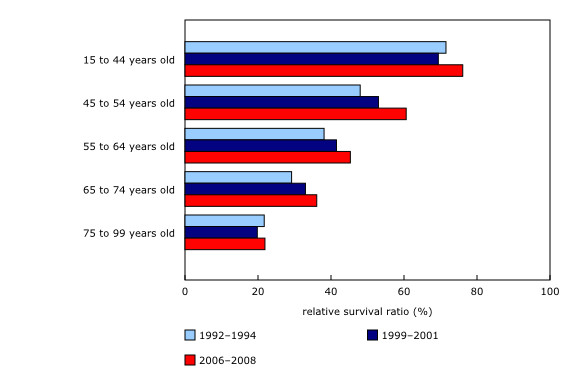Study: Ovarian cancer: Survival statistics, 1992–1994 to 2006–2008
Archived Content
Information identified as archived is provided for reference, research or recordkeeping purposes. It is not subject to the Government of Canada Web Standards and has not been altered or updated since it was archived. Please "contact us" to request a format other than those available.
Released: 2015-09-10
Among women diagnosed between 2006 and 2008, survival from ovarian cancer was lower than survival from other common female reproductive system cancers and lower than survival from all cancers combined.
Five-year survival from ovarian cancer was 45.0%, meaning that women diagnosed with ovarian cancer were 45.0% as likely as comparable women, without ovarian cancer, to survive for five years after being diagnosed.
Women diagnosed before the age of 55 had considerably better five-year survival compared with women of all ages combined (45.0%). Specifically, among women diagnosed between the ages of 15 and 44, five-year survival was 78.4%; and among women diagnosed between the ages of 45 and 54, five-year survival was 62.5%.
Age-standardized survival at 1, 3, 5 and 10 years after diagnosis improved significantly for women diagnosed between 2006 and 2008, compared with women diagnosed between 1992 and 1994. The largest increase in survival, 8.4 percentage points, occurred at three years after diagnosis.
Considering age at diagnosis, the greatest improvement in five-year survival between 1992–1994 and 2006–2008 occurred among women diagnosed between the ages of 45 and 54 (12.6 percentage points). Significant increases in survival were also experienced by women diagnosed between the ages of 55 and 74. There was no significant improvement in five-year survival among women diagnosed between the ages of 15 and 44 and 75 and 99.
Note to readers
When survival estimates from different time periods were compared, the estimates were age-standardized. Age-standardization was used to compare statistics between different time periods as it accounts for the differences in the age distribution of diagnosed cases. In this study, age-standardized estimates were calculated using the direct method which means that the age structure of the population of interest (those diagnosed with ovarian cancer) were mathematically adjusted to have the same age structure as a standard population. The standard population used in this article was women diagnosed with ovarian cancer between 2001 and 2005.
The data in this article are from the Canadian Cancer Registry (CCR) and population life tables. The CCR is a dynamic administrative database of all Canadian residents, alive or dead, who have been diagnosed with cancer since 1992. The CCR is a patient-based system that includes the type and number (incidence) of primary cancers diagnosed for each person until death. Beginning with cases diagnosed in 1992, cancer incidence data collected by provincial and territorial cancer registries have been reported to the CCR, which is maintained by Statistics Canada.
Products
The article "Ovarian Cancer: Survival statistics" in Health at a Glance (82-624-X), is now available from the Browse by key resource module of our website under Publications.
Contact information
For more information, or to enquire about the concepts, methods or data quality of this release, contact us (toll-free 1-800-263-1136; 514-283-8300; infostats@statcan.gc.ca) or Media Relations (613-951-4636; statcan.mediahotline-ligneinfomedias.statcan@canada.ca).
- Date modified:


